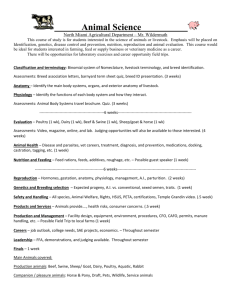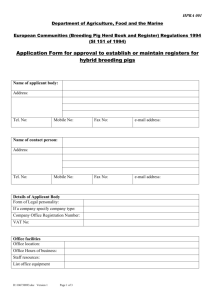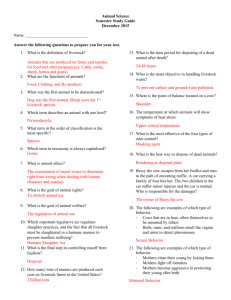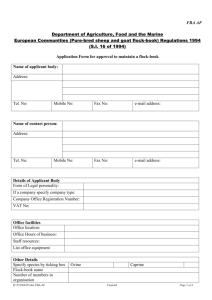Issue #7 - Classic Livestock
advertisement
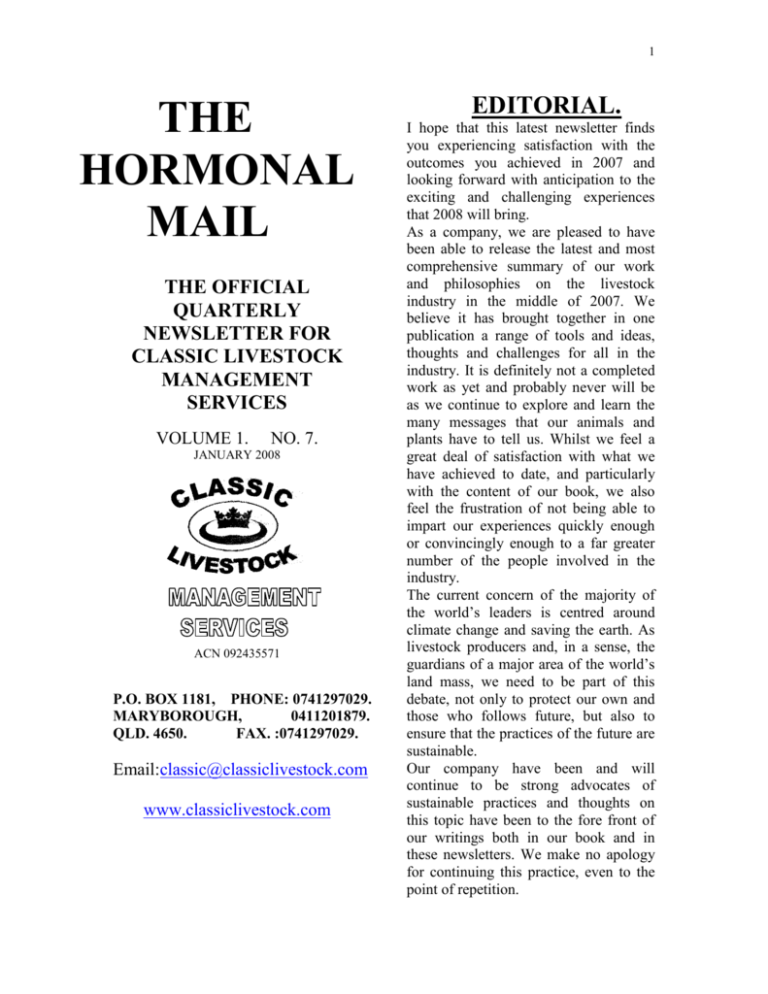
1 THE HORMONAL MAIL THE OFFICIAL QUARTERLY NEWSLETTER FOR CLASSIC LIVESTOCK MANAGEMENT SERVICES VOLUME 1. NO. 7. JANUARY 2008 ACN 092435571 P.O. BOX 1181, PHONE: 0741297029. MARYBOROUGH, 0411201879. QLD. 4650. FAX. :0741297029. Email:classic@classiclivestock.com www.classiclivestock.com EDITORIAL. I hope that this latest newsletter finds you experiencing satisfaction with the outcomes you achieved in 2007 and looking forward with anticipation to the exciting and challenging experiences that 2008 will bring. As a company, we are pleased to have been able to release the latest and most comprehensive summary of our work and philosophies on the livestock industry in the middle of 2007. We believe it has brought together in one publication a range of tools and ideas, thoughts and challenges for all in the industry. It is definitely not a completed work as yet and probably never will be as we continue to explore and learn the many messages that our animals and plants have to tell us. Whilst we feel a great deal of satisfaction with what we have achieved to date, and particularly with the content of our book, we also feel the frustration of not being able to impart our experiences quickly enough or convincingly enough to a far greater number of the people involved in the industry. The current concern of the majority of the world’s leaders is centred around climate change and saving the earth. As livestock producers and, in a sense, the guardians of a major area of the world’s land mass, we need to be part of this debate, not only to protect our own and those who follows future, but also to ensure that the practices of the future are sustainable. Our company have been and will continue to be strong advocates of sustainable practices and thoughts on this topic have been to the fore front of our writings both in our book and in these newsletters. We make no apology for continuing this practice, even to the point of repetition. 2 WHAT’S ON This is not the usual type of subject we mention in this section, but it is a situation that deserves special mention in this edition and it is definitely very current for those involved. Some of you may already be aware that Margie Fry has just undergone some major surgery and is now faced with a long and challenging recuperation over the next few weeks and months. For those of you who don’t know, Margie is the wife of a very close and well respected friend of our company’s, Gearld. Some of us are blessed with being able to meet very special people in our lives, people who are “Masters” of their trade and as such, usually life in general, and Gearld is such a person. Although we haven’t had the pleasure of meeting Margie, we know that she is a very special lady to be the partner of Gearld. We know that she deserves all the combined life energy, prayers and support that we can give her at this time. I know through having had the privilege of sharing time with him that her support and love for Gearld has inspired and encouraged him to do the work that he does and that in turn has also helped to keep our company focused and positive in the direction that we are taking. We wish her a speedy, painless and successful recovery. Fuelling the Future. As mentioned in the editorial, climate change is the current major international issue on everyone’s lips. It is one thing to talk about it, but often a much different thing to actually do something. I thought it might be opportune to mention something that some of our shareholders in Victoria have been doing about it now for some time. In fact, it is around 5 – 6 years since they started collecting the cooking oil from some of the take away food retail outlets in Albury and Wodonga and filtering and blending it to use in their diesel vehicles. An example of the cost effectiveness of this is the example of one of our shareholders who uses it in his Mazda diesel car. He drove it from his home near Tallangatta in North East Victoria to our annual meeting in Tweed Heads on the New South Wales/Queensland border in October, a distance of around 1500 kilometres, for a cost of around $15 total fuel cost. A conventional car of the same size running on diesel would have cost around $150.00. Added to this is the lesser levels of dangerous emission and it is obvious that this option is one that needs to be investigated more fully. The only difference created with the use of this type of fuel is the fish and chips smell discharged until the vehicle motor gets warm. Another very interesting project some of our shareholders in Victoria are becoming involved in is the production of fuel from a range of native vegetation and what potential this may have on a broad scale in the future. This is something that parts of agriculture Australia could well consider as could some of the less wealthy countries in places like Africa. ********************************* PRESUPPOSITIONS. (True or not?) The map is not the territory. The picture is not the person. For things to change, first I must change. Every behaviour has a positive intent. The meaning of communication is the response it produces. There in no failure, only feedback You cannot not communicate. If what you are doing is not working, change it. 3 WHERE TO FROM HERE Even at the risk of getting somewhat repetitious, we would like to continue on the themes of balance, breeding and the long term impact on human health in these newsletters. I have already mentioned frustration in the editorial. In this context, it is our frustration as a company, a group of people who are passionate about the livestock industry and the direction it is taking. We certainly don’t want to revolutionise the industry in any sense of the word. In fact, we readily acknowledge that all we are doing, in fact, is just re-examining and reviewing things that have worked in the past and things that are working now and comparing them to a wider society and time span. We believe that many of the questions we are asking are ones that many people and companies would like to ask, but in most cases, fear of the consequences prevents them from doing so. When you really stop and think, there are so many more questions that can be posed about the whole human, plant and livestock health business that have never been answered than have been. One of our company’s main aims is to encourage support from the general public, or even more critically, from some of the more ecologically responsible corporate sector. Support from this quarter would provide the resources and the commitment to work with us to research more conclusively many of the issues that we know subjectively are happening in the industry so that we can provide the verifiable evidence that today’s technological world needs. We would also hope that there are many more producers out there who have concerns similar to those that we have been expressing, but have yet to find a suitable forum to express them more adequately. We will work with them to develop that suitable forum. The frustration we as a company are feeling is coming from the knowledge that what we have been researching and practicing ourselves what we have been advocating, but are really running out of the resources we need to take the whole business of community awareness and understanding to the next level. Even more importantly, though to convince the decision makers that there is a wider range of agenda that cannot be ignored. Our lives have shown us these things and it is heart breaking to see some of the directions and decisions that are being taken that can only end up in catastrophe. We have demonstrated that we are prepared to play a leading role in changing attitudes and practices and would not be asking for support if we didn’t believe in what we are doing. At this stage we are prepared to consider a wide range of options that might come from the general public as to how we can progress from here. Please feel free to call and discuss this with us. ********************************* MORE PRESUPPOSITIONS. Always add choice, never take away. You cannot not influence. There are no resistant people, just inflexible communicators. There are no unresourceful people, only unresourceful states. Respect the other person’s model of the world. Everything that everyone does makes sense to them at that particular moment. 4 EXECUTIVE SUMMARY Following on the article above in regard to “Where to from Here”, we thought it would be appropriate to add a copy of our company executive summary to firstly, reinforce to those interested our commitment to what we are doing and, secondly, to provide information to anyone out there who might be interested in having a greater involvement with us. INTRODUCTION. This executive summary has been prepared to briefly outline the role of Classic Livestock Management Services as a company that has a major, if not revolutionary, contribution to make to the International livestock industry. To fully meet the potential of the system in a realistic time frame, the company will need support from partners and investors in several areas of specialized expertise. This document is an introduction to many opportunities for those who have the vision and motivation to be part of a dynamic future livestock industry. MISSION STATEMENT. To provide a service that encourages the production of livestock within a balanced system to increase productivity and quality in all sectors of the industry. OBJECTIVES. 1. Provide a reliable, repeatable method of livestock evaluation and access to a graded and registered gene pool for producers. 2. Maintain high quality control standards of all services. 3. Administer the financial transactions of the company. 4. Maintain a well trained staff on a contract basis to provide services and train new staff where applicable. 5. Conduct regular research to provide verification of the system and management strategies and maintain a leading edge in business and ecommerce technology. 6. Provide support and expertise to regional producer and investor groups to enable them to set up their own management and marketing business with the flexibility to meet local situations. 7. Co-ordinate market requirements between producer and investor groups to ensure a continuity of product to all established markets. COMPANY STRUCTURE. 1. Classic Livestock Management Services is a proprietary company. 2. It consists of thirteen shareholders who have a wide range of experience and skills in animal production and associated businesses. 3. Company personnel have experience in a range of key management areas such as pasture production, grazing management systems, fodder conservation, feedlot rationing and processing. 4. Intellectual property is being established to give future shareholders tangible assets to support their investment. 5. Annual general meetings are held for the election of office bearers and presentation of the annual report. 5 HISTORY. The company’s aim is to promote a universally acceptable method of livestock evaluation that will guarantee quality and consistency for producers and consumers. Research into a range of other selection methods and grading systems, along with our own experience over many years has led to this system being developed today that is capable of delivering in excess of a 97% success rate with cattle for high meat quality. Whilst it is primarily a subjective system, the company is continually working to support it with objective methods. THE PRODUCT. Consumer feedback and taste tests have given us the confidence in the system to know that it will provide us with the product that is most desired by the consumer. The majority of our work has been done with cattle, but we are confident that the same traits will carry a similar influence in all cloven hoofed animals. The company has identified 17 key traits that can be visually and kinesthetically assessed and scored by trained evaluators. These traits, combined with other identified supporting traits detailed in the book explaining the company’s system, concentrate on selecting for breeding purposes i.e. maternal traits and for meat and milk quality. SYSTEM ADVANTAGES The major advantage of the CLMS system is that it has the capability to select animals on the hoof in a matter of minutes or less, as compared with other meat and milk grading systems that primarily grade after slaughter or, alternatively, take DNA samples that requires a week or more to provide a result. This ensures, for example, that high scoring breeding animals are not slaughtered, but used to breed from, thus increasing the herd percentage of the gene pool necessary for increasing the production of these quality animals. We have established that the required traits can be found in all breeds, although some of the older, less popular breeds tend to have a higher percentage of better grading animals. It appears likely that popular breeds have been more genetically manipulated in recent years to produce highly only in one or two areas e.g. growth rates and milk quantity. We have an open mind about what influence this might have on the consumer’s health. THE FUTURE. Three key areas have been identified for immediate attention. 1. Establish a genetic pool of registered animals grading to the premium standard using the CLMS system to use as the foundation stock that will be available to all producers recognizing the many advantages of breeding this type of animal. 2. The development of devices capable of scanning the intramuscular fat, back fat and bone of animals and evaluating the results to provide an objective assessment compatible with the current subjective evaluating method. 3. The marketing of new value added products already developed by the company. 6 CONCLUSION. Classic Livestock Management Services is a company committed to a thorough examination of current livestock practices and the effect they are having on the general health of consumers of agricultural products. We believe that there is a delicate, but discernable balance between breeding practices, feeding and management strategies in the livestock industry that not only affects the quality of livestock we produce, but also the quality of the product that they produce. This quality does have an impact on human health and the philosophy behind our company centres on finding and maintaining this balance throughout the food chain. We invite interested parties to contact us to discuss how they may be part of a very humanitarian approach to agricultural production. Further information is available from the company website: www.classiclivestock.com or from the information contained in our book “The Vision Tender.” **************************** NEVER LIE TO A WOMAN A man called home to his wife and said, "Honey I have been asked to go fishing up in Canada with my boss & several of his friends. We'll be gone for a week. This is a good opportunity for me to get that promotion I've been wanting, so could you please pack enough clothes for a week and set out my rod and fishing box. We're leaving from the office & I will swing by the house to pick my things up" Oh! Please pack my new blue silk pajamas." The wife thinks this sounds a bit fishy but being the good wife she is did exactly what her husband asked. The following weekend he came home a little tired but otherwise looking good. The wife welcomed him home and asked if he caught many fish? He said, "Yes! Lots of Salmon, some Bluegill, and a few Swordfish. But why didn't you pack my new blue silk pajamas like I asked you to Dear?" You'll love the answer... The wife replied, "I did. They're in your fishing box....." ********************************* MIND WORDS. (Yes there’s still more) 1. C C C C C C C 2. LU CKY 3. GIVE GIVE GIVE GIVE GET GET GET GET 4. LE / VEL 5. T O W N 6. AID < AID AID 7. TO CH U 8. ECNALG ********************************* 7 BALANCED BREEDING. By balance in breeding in the following context we are referring to two main areas. The first is that the main traits we have identified as being important for meat and milk quality are present in a dominant, consistently high and even level in an animal. The second is the repeatability of these main traits across each herd and through repeated generations of the same family. It would seem that the cattle industry in particular and I guess most livestock industries have been influenced by the notion that all change is good change. That is the impression that one gets when you read the promotional literature that advocates the features of various breeds and how they have suddenly found a “wonder” feature that makes their breed better than any of the others. How many times over the last forty plus years have we seen a certain previously obscure breed or “unknown” feature of better know breed suddenly discovered by the marketers. You would expect that people who have been involved in the industry for many years would ask how this feature suddenly just appeared. The promoters would say that it was genetic progress. Of course, the advantages of this particular feature have to be examined, but the question remains as to how this feature suddenly appeared in a breed that has hundreds of years of history of consistently producing certain recognisable confirmation features. What has triggered this sudden change? How many times have we read of such a promotion that appears overnight and makes some promoters a lot of money and then within a few years it has either disappeared or more likely been recognised for what it was and that was a promotional exercise to improve the profile of a certain breed whose promoters had the money to do it and ultimately were the only ones who received anything back. The main reason for these “flash in the pan episodes” is the introduction of some outside bloodlines whether they be from outside the particular breed in question or from the same breed but from a totally different family and often environment. The initial introduction of these more dominant genes give the original animals a hybrid vigour type boost. However, as the gene pool becomes diluted through breeding away from the originally introduced genes, the advantages become less until ultimately they are unrecognisable and the early advantages have disappeared. This type of breeding does not lead to a balanced, consistent herd or a sustainable balance between the traits that most significantly influence quality. Since our company have started to look more closely at milk quality and its relationship to meat quality in cattle and developed our grading system to include measurements to meet this need, we have found very few cattle that consistently score well across all of our evaluation criteria. In fact, we have found only a handful of cattle that score even average or above over all traits. These cattle have always been of a pure breed and there has always been some traceability of their lineage indicating closed breeding. On the other hand, other observations that we have made is that we have never observed anything like a balance across any cross breeds. They may score highly in one or two traits, moderately in a couple more, but then fall away with others. For example, they may have a 8 reasonably large escutcheon which indicates the capacity for high milk yield, but then have no indication of high butter fat content for protein, their adrenal swirl could be average, they may show low hormonal activity in their coat but indicate reasonably tender meat. It could be argued that our system is so subjective that it is rarely accurate and therefore inconclusive. Certainly, that is an argument that we will consider if those making it can conclusively prove it. We have evaluated enough cattle to be convinced that just through sheer numbers that we have looked at it would make any argument on this basis very difficult to sustain. However, we would welcome the challenge to prove the sceptics wrong. Many breed societies and promoters of the industry must feel they have to keep coming up with changes, which in reality can be termed little more than gimmicks in most cases to show that their breed or particular area of interest is going forward. History surely has proven that going forward doesn’t always necessitate doing something new or even different. What is wrong with striving to do what works even better. We believe that we can show that what the older generation cattlemen advocated and practiced with their line and/or closed breeding programs was the very balance and consistency that we are not seeing in today’s herds. Our research and experience reinforce this fact. So does the fact that it is very difficult to find a breeder who is producing a run of calves year in and year out that look like peas in a pod and have consistent and regularly high weight gains. Cattle breeds were originally bred to meet specific purposes and a specific environment. They were bred for centuries to achieve this and developed their own breed traits, confirmation and character. Their offspring were predictable and could be guaranteed to replicate the mould. However, introducing outside blood threw the system into genetic chaos, balance is lost and consistency disappears out the window. Sure, we may get an animal that grows quicker or produces more milk, but is the meat still tender and tasty? We don’t know really until it is in our mouth. Will the meat from the next animal be the same? Very unlikely because it has been cross bred to meet the demands of the feed and processing industry who are really only interested in profit at all cost. Our argument is that this type of breeding approach is destroying our ability to breed with balance and consistency and must be corrected very quickly to avoid long term disaster. **************************** ANSWERS TO MIND WORDS. 1. 2. 3. 4. 5. 6. 7. 8. The seven seas. A lucky break Forgive and forget Split level Down town First Aid You are out of touch A backward glance. PLEASE FEEL FREE TO CONTACT US ABOUT ANY ITEMS IN THIS NEWSLETTER, ON OUR WEBSITE OR IN OUR NEW MANUAL. WE WELCOME PRODUCER INPUT AND INTEREST AND WANT TO INVOLVE YOU IN WHAT WE ARE DOING. Disclaimer: - Information contained in this newsletter is believed to be true and accurate at the time of publication. Classic Livestock Management Services is not liable to any person or organisation, whether in negligence or other wise for anything published or omitted from this publication.


